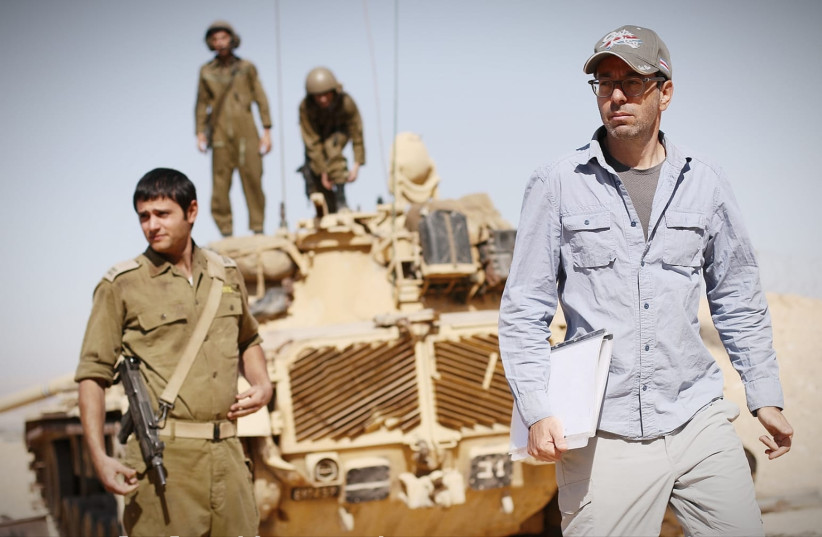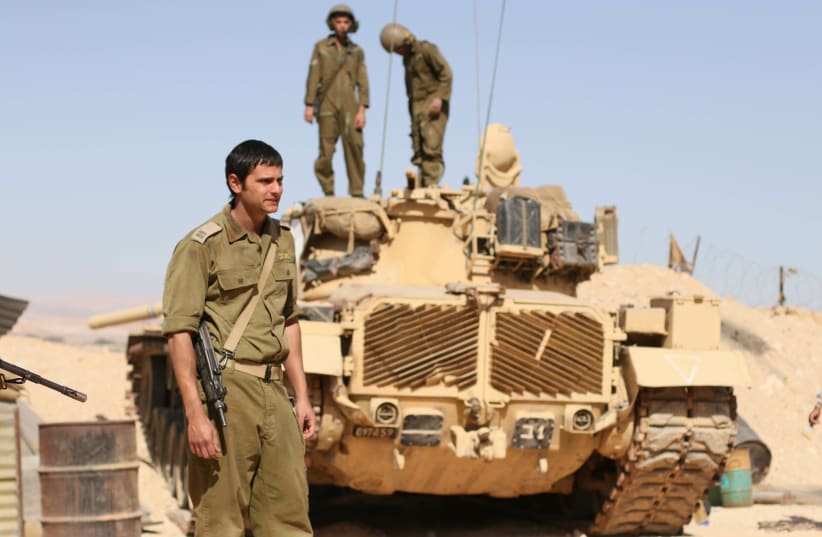“The real story became my compass,” said Lior Chefetz, the director of The Stronghold, a fact-based movie about an outpost of the Israeli army on the Suez Canal during the Yom Kippur War, currently playing in theaters throughout Israel.
Chefetz sat down for an interview at Cinema City Jerusalem just before he was set to address current members of the 401st tank brigade, the brigade portrayed in the movie, who were watching the film as we spoke.
An expanded version of the movie will be released as a television series to mark the 50th anniversary of the war in October on Kan 11, which was one of the producers.
“The movie is an old-school war film, but the series has more developed supporting characters, it shows more of the homefront, it goes into the debates that went on in the military headquarters,” said Chefetz. The series, he noted, is also easier to watch than the movie, in that it doesn’t focus as closely on bloody injuries, which are understandably disturbing (although absolutely necessary) when seen on the big screen.
What is the story of The Stronghold?
The Stronghold is based in large part on a blog written by Dr. Nahum Werbin, portrayed on screen by Michael Aloni.


He arrives at the remote Sinai outpost expecting nothing more taxing than giving out aspirin and blister cream. The outpost is commanded by Shlomo Erdinast (Daniel Gad), a soldier from a Hesder yeshiva, who is expecting that Yom Kippur deep in the Sinai will be as quiet as every other day, marked only by prayers and fasting. But when the Egyptian army launches an all-out attack by air, land, and sea on October 6, Shlomo is forced to try to defend the 42 soldiers under his command with the scant resources he has at hand.
Nahum tries frantically to save critically injured soldiers with very limited medical supplies and is even forced to operate with no anesthesia. Outmanned and outgunned, the unit tries its best, but the casualties and deaths mount and their communications with headquarters become ever more fraught as Werbin pushes for them to surrender and save the wounded soldiers, while Erdinast feels they should continue fighting, understandably scared that the Egyptians might kill them all and convinced that this is simply the right thing to do.
Releasing The Stronghold as both a movie and a series may be unusual, but it’s fitting because Chefetz is an unusual director. The son of a doctor who fought in the Yom Kippur War and who passed away recently during the COVID pandemic, Chefetz grew up fascinated by his father’s album of photos from the war. His father was with an armored brigade that was sent to cross the canal into Egypt.
The pictures in his father’s album were “like a view from another planet... in the desert, from the sand to the horizon there are hundreds and hundreds of burned-out tanks... He wasn’t a photographer [usually], [so] these photographs honored the importance of going to war,” Chefetz said.
“I was curious about the war, it had this monumental scale, like the level of a World War II battle, with the hundreds of tanks and the amount of casualties.”
Chefetz said that as he grew up, “I was walking between the worlds of medicine and art. As a little kid, I liked to draw comics but I was always fascinated by anatomy books.” He volunteered for Magen David Adom and became a combat medic instructor in the army.
Following his army service and a trek to South America, he went to medical school for a year but switched to studying visual communications at the Bezalel Academy of Art and Design in Jerusalem. His parents were “very supportive” of this transition and he went on to get a master’s degree in fine arts at the fabled University of Southern California Film School (USC), whose graduates include George Lucas.
In his very first year there, Chefetz wrote a synopsis for a screenplay about the southern front in the Yom Kippur War. As he tried to develop it, “I looked for a story. I had to find my personal angle. I wasn’t a tank crew member, I wasn’t a paratrooper, I was a combat medic and I knew how a clinic works, how you operate the equipment, all the jargon and I felt comfortable telling a story about that, about the Taagad [the station for treating casualties in the field at the battalion level]. But I couldn’t find a medical story, most of them were a bloodbath... There were stories where you have a doctor and he treats hundreds of casualties.”
As he researched, he came across Werbin’s memoir, which was written as a blog: “The Doctor’s Option,” and published in Hebrew and English to mark the 40th anniversary of the war. The story instantly appealed to him.
“It had military medical action, but also strong human drama,” he said. A crucial part of that drama was the conflict between Werbin and Erdinast over whether to surrender and save the lives of the wounded soldiers or continue to hold out and potentially lose everyone.
“In the core of it was an amazing conflict between two central but opposite values of the IDF,” he said.
Werbin wasn’t going to give his life story to just anyone to film. Chefetz, whose previous credits include the movie Sky Raiders, and who has written for a number of television series, including Line in the Sand, eventually, won over Werbin and his daughter Rana, an editor, and got their blessing to film the story.
Getting the financing was a long process and, in addition to Kan, the movie also received support from United King Films, the Gesher Multicultural Film Fund, and the Rabinovich Foundation for the Arts.
Inspired by such epic war movies as Saving Private Ryan, Band of Brothers, and The Pacific, which were ““very realistic and very emotional and they portray the characters in a heroic way,” he set about creating a screenplay that would tell this complex story, as well as a teleplay for the series. He started reading about and speaking to as many soldiers as he could who had fought in this and similar strongholds and delved into the command logbooks which had been released to the public from the army archives.
Chefetz also listened to the radio communications that were made public.
“I had a huge pile of puzzle pieces. And it wasn’t the same puzzle. Take 20 or 30 puzzles and you put some parts of each puzzle in one huge pile and that’s how I wrote the script,” he said. “Different people telling different stories and I put it in a structure of a Hollywood war movie,” in a process he likened to sewing a quilt.
The shoot was complex logistically and Chefetz spoke very generously of the contribution of his cinematographer, Ram Shweky, to the finished film.
“I do pretty pictures, but Ram has a much more raw style... He made the movie realistic, I couldn’t do it [like that]... He gave the visuals the soul of realism and roughness. So it’s a shared creation.”
Chefetz also has high praise for his cast. All of those who were portraying soldiers in the movie had served in the military.
“This was something that we demanded,” said Chefetz. “Some were in combat units and some were in the IDF theater, but they all served.” Aloni went through some medical training and those playing tank crew members were trained in how to work on a tank.
Chefetz is well aware that the movie and series are being released at such an important moment, not only to mark the 50th anniversary of the war but also during this time of great social and political upheaval sparked by the proposed judicial reforms, and he feels it is an appropriate story for our times.
“I hope The Stronghold will remind people that we’re all brothers and sisters with shared faith, fighting shoulder-to-shoulder, where the differences are not that big, and that we should be listening to each other and debating, in a reasonable way, to solve any disagreements, the way the characters do in the movie, that’s the message,” he said, before heading off to speak to the young soldiers who had just seen The Stronghold.
